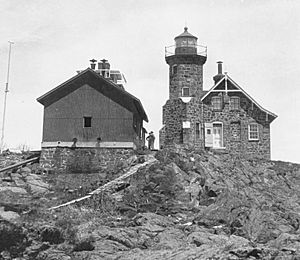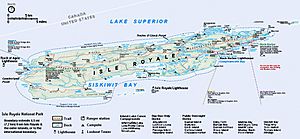Passage Island Light facts for kids
 |
|
| Undated USCG photo of the station | |
|
|
|
| Location | SW end of Passage Is., 3.25 mi NE of Isle Royale, in NW Lake Superior, Houghton Township, Michigan |
|---|---|
| Coordinates | 48°13′27″N 88°21′57″W / 48.22417°N 88.36583°W |
| Year first constructed | 1882 |
| Year first lit | 1882 |
| Automated | 1978 |
| Construction | fieldstone |
| Markings / pattern | natural with white & red lantern |
| Height | 44 feet (13 m) |
| Original lens | Fourth order Fresnel lens |
| Current lens | 7.5-inch (190 mm) |
The Passage Island Light Station is a lighthouse found on Passage Island in Lake Superior, Michigan. It's about 3.25 miles (5.2 km) northeast of Isle Royale. This important lighthouse was added to the National Register of Historic Places in 2006.
Contents
About the Lighthouse

The Passage Island lighthouse tower stands 44 feet (13 meters) tall. It is built from strong field stone. The bottom part of the tower is square. As it goes up, it changes to an eight-sided shape.
At the very top, there is a ten-sided lantern made of cast iron. You can reach this lantern by climbing a spiral staircase inside the tower. The tower is connected to the keeper's house. This house is also made of field stone and has two stories. It measures 26 by 30 feet (7.9 by 9.1 meters).
History of the Light Station
Why a Lighthouse Was Needed
People realized a lighthouse was needed near Passage Island as early as the 1860s. At that time, many ships were traveling on Lake Superior. This was because mining was growing fast in the Upper Peninsula. More ships meant more danger, so a light was important for safety.
Building the Lighthouse
It took a while for the lighthouse to be built. In 1875, the government finally approved money for it. However, the $18,000 set aside for the Passage Light was not released until 1880. This delay happened because the government wanted to encourage Canada to build a lighthouse in Lake Erie.
Construction of the Passage Island Light Station began in 1881. The lighthouse was finished and lit for the first time in 1882.
Changes Over Time
In 1884, a fog signal was added to the station. This helped ships find their way in foggy weather. Ten years later, in 1894, a new flashing white lens was installed. This special lens was made by a company in Paris, France.
In 1978, the lighthouse became automated. This means it no longer needed a keeper living there to operate it. In 1989, a modern 190 mm (7.5 in) acrylic lens was put in. This new lens replaced the older Fresnel lens.


